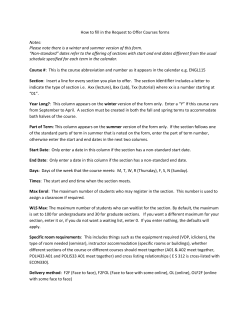
6/1/2012
6/1/2012 Method Development for Testing Androgenic Anabolic Steroids in Oral Fluid and Urine using Turbulent Flow Orbitrap MS Erica A. Guice Western Slope Laboratory, LLC Outline • Why test for steroids in toxicology? • Steps in method development – Specific considerations for oral fluid and urine – Specific considerations for lipids – Common pitfalls • Data • Summary and Acknowledgements Why steroids in toxicology? • • • • Drug-facilitated sexual assault (DFSA) Sports doping Clinical monitoring (e.g. CAH) Criminal Investigation (e.g. causality) 1 6/1/2012 Why steroids in toxicology? • Steroid-induced violence (or ‘Roid Rage ) – More than 20 murders (1996) – Assault, attempted murder, and kidnapping as well • Increased sexual appetite and violence – “Since sexual desire and aggressiveness are increased during AS use, the risk of getting involved in sexual assault may be increased” • Steroid induced death – Cardiovascular effects The long and short….the skinny…perhaps the fat too METHOD DEVELOPMENT Steps in Method Development • • • • • • Step 1: Define method objectives and understand the chemistry – Determine the goals for method development and to understand the chemistry of the analytes. Step 2: Initial Instrument conditions – Develop preliminary conditions to achieve minimally acceptable separations. Step 3: Sample preparation procedure – Develop a suitable sample preparation scheme for the analytes Step 4: Standardization – Determine the appropriate standardization method and the use of relative response factors in calculations Step 5: Final method optimization/robustness – Identify the “weaknesses” of the method and optimize the method through experimental design. Understand the method performance with different conditions, different instrument set ups and different samples. Step 6: Method validation – Complete method validation according to industry appropriate guidelines 2 6/1/2012 Define the Goal of the Method being Developed Understand the Analytes being Tested STEP ONE Goal of testing for steroids: o For forensics: low limits of detection for as many compounds and their analogues o For post mortem: large dynamic range for as many compounds and their analogues o For clinical: low limits of detection for a specific group of compounds o For doping: large dynamic range for a specific group of compounds The Analytes • Androgenic anabolic steroids are hormones that mimic testosterone – They are lipids, but much different structure than the classical lipid – they are non-polar ∴ Need solvent based sample preparation probably SPE and high organic in mobile phases 3 6/1/2012 Initial Instrument Conditions (and selection) STEP TWO Instrumentation • Most labs do not have several different platforms in which to develop their methods. – We must make due with the year, make, and model that is currently present… – This may include forcing analytes on a platform that is not best suited for its chemistry • Be aware that additional method development will be needed in these cases Possible Instrumentation • GC/MS and GC/MS/MS • LC/MS • LC/MS/MS • LC/HR-TOF or LC/HR-MS • GC/HR-TOF 4 6/1/2012 Why Liquid Chromatography… • Derivatization process can be quite lengthy and often times irreproducible. In addition, this process does not generally yield high conversion of the steroid to the derivatized product ∴Liquid can reduce time and sample manipulation, while still allowing for accurate analysis ∴We can take advantage of online sample extraction systems i.e. turbulent flow Why Turbulent Flow Online Extraction? • Reduced ion suppression • Eliminate the need for extensive sample cleanup: – Saving time, money, and people time – Very versatile • Urine • Saliva • Plasma How turbulent flow works… • With a high linear velocity and large particle size, turbulent flow is created inside column • Differences in diffusion rates between large and small molecules is leveraged • Forcing the large molecules through the column while the smaller ones are retained 5 6/1/2012 Instrument requirements with steroids • Resolution of structurally similar compounds, either by chromatography, mass, fragmentation, or combination • Sensitivity to detect as low as femtogram amounts on column; quantify picogram per milliliter solutions • Dynamic range required for industry • Ability to interface with online sample extraction LC/MS vs LC/MS/MS vs LC/HR-TOF or MS SIM vs QQQ • Single Ion Monitoring would require the separation of isobars through chromatography • QQQ would require the use of Ion Ratios to determine of specific compounds (isobars) TOF vs Orbitrap • Both can use CID to provide fragment information • Also use the full scan spectrum for retention time verification • Biggest difference here is dynamic range and spatial/temporal association of the chromatographic data Which instrument meets the needs? SIM (LC/MS) QQQ (LC/MS/MS) Q-TOF (LC/HR-TOF) Orbitrap (LC/HR-MS) Resolution of structurally similar compounds Sensitivity for low limits of detection Dynamic range requirements met Able to do online extraction Maybe 6 6/1/2012 The Column: The Other “Instrument” • With a turbulent flow-liquid chromatography system set-up, there are two columns selections that have a bearing on the results of the method: – The turbulent flow column – The analytical column • Column selection is affected by the pH and the additives used. The Turbulent Flow Column • There are several chemistries that can be employed including: – C8, C18, Fluoro, Phenyl, and C2 • There are 0.5 and 1.0 mm diameter columns available as well; the lengths are all standard The Analytical Column • As usual with any chromatographic method, you have to select the appropriate analytical column chemistry, length, diameter, bead size, and porousity • Cation/Anion exchange can also be utilized depending on the chemistry selected 7 6/1/2012 Sample Preparation STEP THREE Sample Preparation • The common schemes of sample prep are dilute & shoot, solid phase extraction, liquidliquid extraction, protein precipitation, online sample extraction • Keep in mind you will have to validate the sample prep process to ensure that you are not losing too much of your sample during the steps. ∴K.I.S.S. Keep It Simple Science ☺ Standardization STEP FOUR 8 6/1/2012 Standardization • There is a congressional act to standardize steroid testing (109th Congress HR 3084) – But it does not have the support of all major league sports • CDC has a testosterone standardization program • IOC standards (WADA/USADA) But to date, there is no universal regulation that outlines requirements for steroid testing as a national or international standard for clinical, forensics, toxicology, or doping outside of the Olympic regulations Final method optimization Method validation STEP FIVE AND SIX 9 6/1/2012 Final method optimization & validation • Once the sample prep procedure has been finalized, the method is tested with reasonable variables/environments in mind (technicians, temperature, columns, samples, instruments) • Reasonable acceptable criteria for the method must be defined prior to this testing. – e.g. SWGTOX method validation parameters – e.g. FDA method validation parameters Things to watch out for… • The most common pitfalls in developing a method is the focus on the validation, without adequate attention being paid to optimizing the components of the method • Also, with steroids much attention needs to be paid to the endogenous AASs, especially the epimers in sports doping tests • Lower limits of detection at or below the WADA guideline will be required for many compounds Turbulent Flow Optimization TIME FOR SPECIFICS 10 6/1/2012 Try, try, again • With developing a method that uses turbulent flow online sample clean up, the transfer step needs to be optimized so that the compounds of interest are retained on the TF column while sugars, salts, and other matrix components are sent to waste. It is imperative that this step is optimized in order to achieve the best possible chromatographic results Incomplete Transfer Issues • Peak shape, counts, scan number, and signal to noise ratio are all improved when the transfer step is optimized for the compounds tested Turbulent flow parameters 11 6/1/2012 U/HPLC parameters optimized • Once the TF parameters are established, the HPLC conditions must be optimized, with the starting organic and steps of gradient, as applicable. • Moreover, pH and additives can either help or hurt the separation…be cognizant of that Separation of the epimers • Testosterone and epitestosterone separation in oral fluid sample: – Valley consideration? – Separation considerations? – Scans across each peak considerations? Scans across the curve • In order to quantify the amount of the steroid(s) present in any given sample, an appropriate number of scans under the peak is required. • If qual-quan peaks are used, it is encouraged that both have the appropriate amount of scans 12 6/1/2012 Once Optimized…. •You will be able to quantify steroids within the dynamic range that the method was validated for. Summary • When developing a method for AAS, be sure to consider – sample preparation and clean-up – matrix of the sample – validation and standardization protocols • Consider instrumentation… – Not all instruments are created equal Acknowledgements • Western Slope Laboratory, LLC – Matt Pentis – Jessica Marsh • Thermo Fisher Scientific – Jeff Zonderman – Marta Kozak – Kevin He – Kristine Van Natta – Subodh Nimkar 13 6/1/2012 References Pope and Katz, J Clin Psychiatry 1990 51(1): 28-31 Occhipinti http://www.afpafitness.com/articles/articles-andnewletters/research-articles-index/anabolic-steroids-and-thedepression-connection/ Wedro and Shiel Jr http://www.steroidology.com/anabolicsteroid-side-effects-and-addiction/ http://dwb.unl.edu/teacher/nsf/c10/c10links/www.tcada.state.t x.us/research/facts/steroids.html www.cvg.ca/images/HPLC_Method_Development.pdf Bowden et al Anal Chem 2009 81(16):6725-34 www.bodybuilding.com search: supplement stacks Sokahalv isteroids.com/steroids/Best%20steroids.html www.extenze.com/faq.asp 14
© Copyright 2025





















